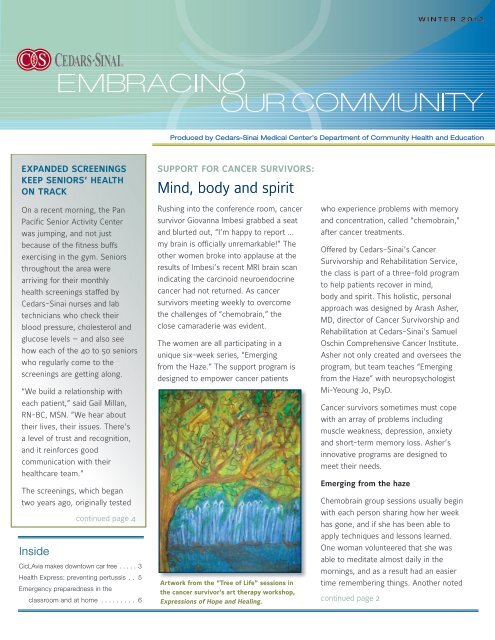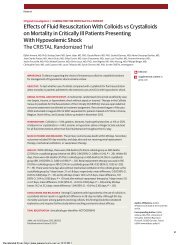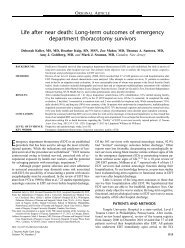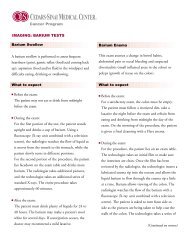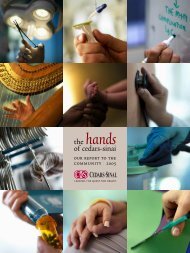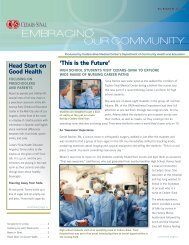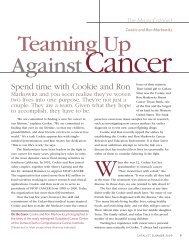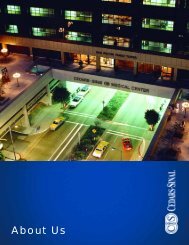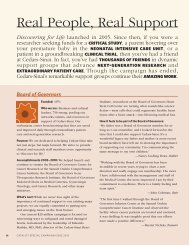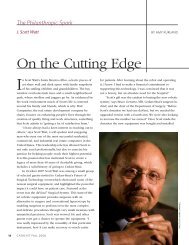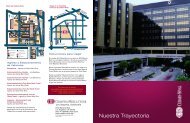Winter 2012 - Cedars-Sinai
Winter 2012 - Cedars-Sinai
Winter 2012 - Cedars-Sinai
You also want an ePaper? Increase the reach of your titles
YUMPU automatically turns print PDFs into web optimized ePapers that Google loves.
WINTER <strong>2012</strong><br />
EXPANDED SCREENINGS<br />
KEEP SENIORS’ HEALTH<br />
ON TRACK<br />
On a recent morning, the Pan<br />
Pacific Senior Activity Center<br />
was jumping, and not just<br />
because of the fitness buffs<br />
exercising in the gym. Seniors<br />
throughout the area were<br />
arriving for their monthly<br />
health screenings staffed by<br />
<strong>Cedars</strong>-<strong>Sinai</strong> nurses and lab<br />
technicians who check their<br />
blood pressure, cholesterol and<br />
glucose levels — and also see<br />
how each of the 40 to 50 seniors<br />
who regularly come to the<br />
screenings are getting along.<br />
“We build a relationship with<br />
each patient,” said Gail Millan,<br />
RN-BC, MSN. ”We hear about<br />
their lives, their issues. There’s<br />
a level of trust and recognition,<br />
and it reinforces good<br />
communication with their<br />
healthcare team.”<br />
The screenings, which began<br />
two years ago, originally tested<br />
Inside<br />
continued page 4<br />
CicLAvia makes downtown car free. .....3<br />
Health Express: preventing pertussis. .. 5<br />
Emergency preparedness in the<br />
classroom and at home .......... 6<br />
SUPPORT FOR CANCER SURVIVORS:<br />
Mind, body and spirit<br />
Rushing into the conference room, cancer<br />
survivor Giovanna Imbesi grabbed a seat<br />
and blurted out, “I’m happy to report …<br />
my brain is officially unremarkable!” The<br />
other women broke into applause at the<br />
results of Imbesi’s recent MRI brain scan<br />
indicating the carcinoid neuroendocrine<br />
cancer had not returned. As cancer<br />
survivors meeting weekly to overcome<br />
the challenges of “chemobrain,” the<br />
close camaraderie was evident.<br />
The women are all participating in a<br />
unique six-week series, “Emerging<br />
from the Haze.” The support program is<br />
designed to empower cancer patients<br />
Artwork from the “Tree of Life” sessions in<br />
the cancer survivor’s art therapy workshop,<br />
Expressions of Hope and Healing.<br />
who experience problems with memory<br />
and concentration, called “chemobrain,”<br />
after cancer treatments.<br />
Offered by <strong>Cedars</strong>-<strong>Sinai</strong>’s Cancer<br />
Survivorship and Rehabilitation Service,<br />
the class is part of a three-fold program<br />
to help patients recover in mind,<br />
body and spirit. This holistic, personal<br />
approach was designed by Arash Asher,<br />
MD, director of Cancer Survivorship and<br />
Rehabilitation at <strong>Cedars</strong>-<strong>Sinai</strong>’s Samuel<br />
Oschin Comprehensive Cancer Institute.<br />
Asher not only created and oversees the<br />
program, but team teaches “Emerging<br />
from the Haze” with neuropsychologist<br />
Mi-Yeoung Jo, PsyD.<br />
Cancer survivors sometimes must cope<br />
with an array of problems including<br />
muscle weakness, depression, anxiety<br />
and short-term memory loss. Asher’s<br />
innovative programs are designed to<br />
meet their needs.<br />
Emerging from the haze<br />
Chemobrain group sessions usually begin<br />
with each person sharing how her week<br />
has gone, and if she has been able to<br />
apply techniques and lessons learned.<br />
One woman volunteered that she was<br />
able to meditate almost daily in the<br />
mornings, and as a result had an easier<br />
time remembering things. Another noted<br />
continued page 2
EMBRACING OUR COMMUNITY PAGE 2<br />
SUPPORT FOR CANCER SURVIVORS MIND, BODY AND SPIRIT<br />
continued from page 1<br />
that she was making an effort to do<br />
only one thing at a time, otherwise<br />
she could never finish anything. She<br />
identified music as a distraction. “My<br />
focus was on the music, rather than<br />
having it in the background.” The<br />
hard part she said was telling her son<br />
to “turn off the music!” Both women<br />
talked about the challenges of dealing<br />
with family members who can’t<br />
relate to someone who needs time to<br />
meditate, or to focus on one thing at a<br />
time, rather than multi-tasking. Those<br />
who could relate, nodded and smiled.<br />
Cancer survivor Carol Parks with Arash Asher, MD.<br />
Jo showed a brief video about ways to<br />
enhance memory. Afterward, the group<br />
engaged in memory-building exercises.<br />
“As we practice over and over, we can<br />
develop new (memory) skills, regardless<br />
of where we are right now,” Asher<br />
emphasized, offering encouragement.<br />
The healing energy of art<br />
In the calm conference room, soft<br />
strains of music accompany the six<br />
people at the table working quietly on<br />
their art while sipping herbal tea and<br />
enjoying slices<br />
of fresh fruit.<br />
In the heart of<br />
<strong>Cedars</strong>-<strong>Sinai</strong>’s<br />
Samuel Oschin<br />
Cancer Center,<br />
this soothing<br />
and supportive<br />
atmosphere<br />
is created by<br />
Expressions<br />
of Hope and<br />
Healing, an<br />
art therapy<br />
class. This is<br />
the second<br />
component of<br />
the revolutionary<br />
cancer<br />
rehabilitation<br />
program<br />
developed by<br />
Asher: “To<br />
heal the whole<br />
cancer patient<br />
— to get them<br />
back to their<br />
highest quality<br />
of life.”<br />
It’s an approach that’s never been<br />
more relevant. According to the<br />
National Cancer Institute, the<br />
population of cancer survivors is<br />
approaching 12 million, or 3 percent<br />
of the U.S. population. And the overall<br />
five-year survival rate for all cancers<br />
combined is 67 percent. As optimistic<br />
as these numbers are, it also means<br />
that more people than ever are facing<br />
a long-term struggle with cancer’s<br />
residual issues. Taking heed of these<br />
numbers, <strong>Cedars</strong>-<strong>Sinai</strong> has taken<br />
an active role to create programs<br />
and support services that address<br />
quality of life issues affecting this<br />
growing population.<br />
The eight-week art class is one very<br />
important way in which the healing<br />
begins, gains strength and carries the<br />
patient forward to a new way of living<br />
his or her life. Led by artist and 14-year<br />
cancer survivor Flori Hendron, who<br />
found that her own once-frail condition<br />
started to improve when she resumed<br />
painting, Expressions of Hope and<br />
Healing creates a safe haven where<br />
patients can find meaning in their<br />
cancer experience by creating art.<br />
Hendron references The Hero’s<br />
Journey from Joseph Campbell’s 1949<br />
bestseller, “The Hero With a Thousand<br />
Faces,” to help the members of her<br />
class confront fear, cultivate strength<br />
and sustain a positive approach to the<br />
experience. Whether they’re designing<br />
Mandalas, the Hindu symbol for<br />
enlightenment and ultimate healing,<br />
or participating in a unique, two-part<br />
session in which each patient creates<br />
his or her own “Tree of Life,” the idea<br />
continued next page
CICLAVIA MAKES DOWNTOWN LOS ANGELES<br />
CAR FREE AND FREEWHEELING<br />
Imagine Los Angeles without cars.<br />
For five sun-filled hours on a Sunday<br />
morning in October, the streets<br />
of downtown Los Angeles were<br />
transformed into 10.5 miles of car-free<br />
streets, open for walking and bicycling.<br />
The atmosphere was festive as an<br />
estimated 130,000 people joined in the<br />
fun of the second annual CicLAvia.<br />
With 36 nurses staffing six first aid<br />
stations, treating scrapes and other<br />
medical needs along the route, “the<br />
people of <strong>Cedars</strong>-<strong>Sinai</strong> are here taking<br />
care of the people of Los Angeles,”<br />
said Linda Burnes Bolton, DrPH, RN,<br />
FAAN, vice president and chief nursing<br />
officer. Additionally, <strong>Cedars</strong>-<strong>Sinai</strong><br />
served as an organizing partner of<br />
this year’s event with the City of Los<br />
Angeles, METRO, Choose Health LA<br />
and the Los Angeles County Bicycle<br />
Coalition.<br />
From Chinatown to El Pueblo de Los<br />
Angeles to MacArthur Park, “everyone<br />
who stops by is so happy that we’re<br />
here,” said Burnes Bolton, “and<br />
so are we.”<br />
After taking a tumble from his bike, Greg<br />
Guillermo receives cold packs and a sling<br />
from <strong>Cedars</strong>-<strong>Sinai</strong> RNs.<br />
An organizing partner of CicLAvia 2011, <strong>Cedars</strong>-<strong>Sinai</strong> sent 36 RNs from the Medical Center to<br />
staff six first-aid stations along the 10.5-mile downtown L.A. Route.<br />
SUPPORT FOR CANCER SURVIVORS, continued from page 2<br />
is to move forward in the survival<br />
process “in steps that cycle back into<br />
living life.”<br />
Strength, Endurance and<br />
Empowerment<br />
The third element in the program,<br />
Cancer Exercise Recovery, addresses<br />
physical issues with a specially tailored<br />
exercise program with a personal<br />
trainer designed to give cancer patients<br />
the strength, endurance and independence<br />
necessary to function at their<br />
maximum level.<br />
“Research shows that physical activity<br />
after cancer treatment helps reduce<br />
fatigue, as well as increase strength<br />
and endurance,” Asher said. “But this<br />
program does more than strengthen<br />
after-cancer bodies. It empowers<br />
the participants in every aspect of<br />
their lives.”<br />
Asher regularly receives emails and<br />
letters from those who have benefited<br />
from one or more of the support<br />
programs. Carol Parks, who lives in<br />
the Windsor Hills area of Los Angeles,<br />
emailed Asher about her experience<br />
taking the art workshops. “Flori’s<br />
classes were liberating. As a result …<br />
I’ve begun a path of self-rediscovery<br />
that I hope will help me move forward in<br />
my recovery and sustain my remission.”
Senior Screenings Focus on Diabetes and Heart Health<br />
continued from page 1<br />
only for blood pressure, then<br />
were expanded to meet specific<br />
health needs of area seniors.<br />
Today, <strong>Cedars</strong>-<strong>Sinai</strong> offers medical<br />
screenings in 13 underserved<br />
communities throughout Los Angeles.<br />
“We had constant requests to check<br />
“The card is a great<br />
opportunity to<br />
educate people<br />
about diabetes,<br />
nutrition and weight<br />
management.”<br />
—Logan Williams<br />
associate director,<br />
<strong>Cedars</strong>-<strong>Sinai</strong> Community<br />
Health and Education<br />
for cholesterol and glucose. Now we<br />
have a test that takes just a little more<br />
than two minutes to provide total<br />
cholesterol and glucose levels,” said<br />
Logan Williams, associate director,<br />
Community Health and Education.<br />
Another valuable part of the program<br />
is a personalized Health Information<br />
Card given to each senior. “The card is<br />
a great opportunity to educate people<br />
about diabetes, nutrition and weight<br />
management. Seniors bring it back<br />
every month. It tracks their history<br />
and they can also show it to their<br />
doctor,” Williams said. <strong>Cedars</strong>-<strong>Sinai</strong><br />
also provides a physician and clinic<br />
referral system for those without a<br />
regular doctor.<br />
Seniors take an active role in maintaining their health at <strong>Cedars</strong>-<strong>Sinai</strong>’s free monthly<br />
screenings for blood pressure, diabetes and cholesterol.<br />
And seniors are spreading the word.<br />
“Someone went through the screening<br />
process and came back with a friend.<br />
It doesn’t get much better than that.<br />
That is the measure of success,”<br />
Millan said.<br />
One more measure of success is seen<br />
as seniors focus on health<br />
and change their habits.<br />
Los Angeles resident Alicia<br />
Lampano said, “My eating<br />
habits have changed. Before<br />
(the screenings) I would eat<br />
anything. Now I’m more<br />
watchful. I eat more fruits.<br />
I eat salad for my blood<br />
pressure.” Another screening<br />
regular, Miriam Netkin, 91,<br />
also made changes. “Thanks<br />
to these tests, I have slowed<br />
down, and I’m taking it a little bit<br />
easier.” Marty Hillman, 83, pays close<br />
attention to the results on his health<br />
information card. “I show these to<br />
my doctor when I go in to see him.<br />
It makes me feel good that I know<br />
nothing’s wrong.”<br />
Bilingual <strong>Cedars</strong>-<strong>Sinai</strong> RNs who volunteer at monthly<br />
senior health screenings know that caring is the same<br />
in every language.
EMBRACING OUR COMMUNITY PAGE 5<br />
HEALTH EXPRESS: Four<br />
things you should know to<br />
prevent pertussis<br />
Following these important steps<br />
will help keep the whole family<br />
safe from pertussis.<br />
COACH Puts the Brakes on Pertussis and<br />
Gets Kids Back to School<br />
1The Tdap vaccine<br />
is recommended for<br />
pre-adolescents<br />
age 11-12. Infants<br />
should have<br />
pertussis<br />
vaccinations<br />
at 2, 4, 6 and<br />
15 months<br />
of age.<br />
2Keep accurate records of children’s<br />
vaccine history, and<br />
immunize any adults<br />
in the house who<br />
might have let their<br />
protection lapse.<br />
A returning middle school student gets a newly mandated back-to-school immunization.<br />
3<br />
4<br />
Newborns<br />
Wash your hands. Hand<br />
hygiene is one of the<br />
most effective ways<br />
of preventing<br />
the spread of<br />
the pertussis<br />
bacteria.<br />
should be<br />
kept at home, safely<br />
away from public<br />
places where<br />
pertussis bacteria<br />
might be on the<br />
move.<br />
Pertussis, also known as whooping cough, is a highly contagious bacterial infection<br />
of the respiratory tract that is experiencing a significant resurgence in California,<br />
with the state reporting its largest increase in cases since 1955.<br />
Infants and young children up to age 10 are most vulnerable to the disease,<br />
which is often transmitted by adults and older siblings. As a result, state health<br />
officials mandated a new policy for returning middle and high school students:<br />
no shot – no school.<br />
The new policy resulted in students lining up as early as 5:45 a.m. on an August<br />
morning outside the Monroe Middle School, in Inglewood, waiting for <strong>Cedars</strong>-<strong>Sinai</strong>’s<br />
COACH for Kids and Their Families ® mobile pediatric clinic, a program of the Maxine<br />
Dunitz Children’s Health Center. Health professionals were offering the Tdap vaccine<br />
(a combination vaccine that prevents tetanus, diphtheria and pertussis) free of<br />
charge to Monroe students, as well as other area middle school students.<br />
“<strong>Cedars</strong>-<strong>Sinai</strong> provides an invaluable service to families that don’t have the resources<br />
or the time to get their kids immunized. For a mobile unit to come to them is such a<br />
great thing,” said Brent Tilley, Monroe’s principal. Immunization is an urgent health<br />
issue, one that <strong>Cedars</strong>-<strong>Sinai</strong> is addressing in underserved communities throughout<br />
Los Angeles.
Emergency preparedness in the classroom and at home<br />
<strong>Cedars</strong>-<strong>Sinai</strong>’s Community Health Initiatives team recently donated 36 emergency<br />
backpacks to Queen Anne Place Elementary School in Los Angeles’ Mid-Wilshire<br />
district. Designed to equip every classroom with basic first-aid supplies, the<br />
backpacks were presented at an all-school assembly where students learned<br />
emergency tips from Ryan Tuchmayer, <strong>Cedars</strong>-<strong>Sinai</strong>’s disaster/surge coordinator.<br />
Vital tips included:<br />
Create an emergency kit at home. Contents should include:<br />
• First-aid kit<br />
•<br />
• Flashlight<br />
Portable radio<br />
• Batteries<br />
Develop an emergency plan for home and family similar to the one at<br />
school. Know the answers to these key questions:<br />
• What do you do during an emergency?<br />
• Where do you go?<br />
• Whom can you call?<br />
Practice implementing the plan and using the emergency kit so that you are<br />
ready when an emergency strikes.<br />
Presenting the emergency backpacks were (from left)<br />
Cindy Levey, associate director, Community Health<br />
Initiatives, <strong>Cedars</strong>-<strong>Sinai</strong>; and from Queen Anne Place<br />
Elementary, Rowel Salvador, principal; Jeanette Ward,<br />
former Healthy Start coordinator; and Ashley Benjamin,<br />
PhD, intervention coordinator.<br />
Young students eagerly await<br />
the assembly on emergency<br />
preparedness.<br />
Contact Information<br />
For more information about this newsletter,<br />
please contact Cindy Levey, MPH, associate<br />
director, Community Health Initiatives,<br />
(323) 866-2997, or cindy.levey@cshs.org.<br />
Caring for Our Community<br />
Meeting the health needs of the wider<br />
community has been an integral part of<br />
<strong>Cedars</strong>-<strong>Sinai</strong>’s mission for more than 100<br />
years. The Medical Center is actively working<br />
to improve the health of the most vulnerable<br />
in our community. As a leading nonprofit<br />
hospital, our commitment to community<br />
benefit can be clearly seen in three<br />
key areas:<br />
• Providing access to essential healthcare<br />
for those in greatest need, including the<br />
uninsured and underinsured;<br />
• Empowering communities to become<br />
healthier through vital prevention programs<br />
and services in public schools, senior<br />
centers, mobile clinics and more;<br />
• Offering education and research programs<br />
to prepare the next generation of<br />
healthcare professionals, and expand the<br />
horizons of medical knowledge.


